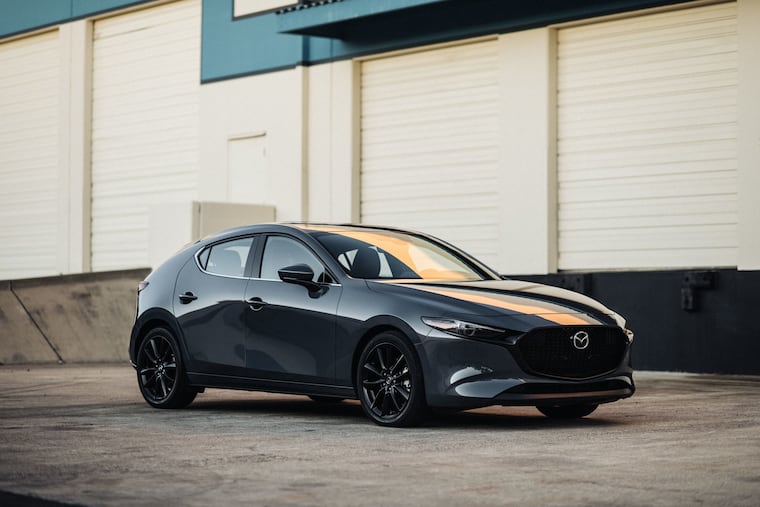The Mazda3-Nissan Sentra skirmish: Which little car will prevail?
The Mazda3 AWD Hatchback gets another crack at Driver's Seat. In last year's competition, it fell to the Toyota Corolla Hatchback (!) for fun driving, fuel economy, and small-car usefulness, though it bested the Kia Forte. How will it stand up to the redesigned Nissan Sentra?

2020 Mazda3 Hatchback AWD with Premium Package vs. 2020 Nissan Sentra 2.0 SR CVT: I bet you think you can predict the winner. But read on.
This week: Mazda3.
Price: $32,065 as tested. Paint, sill lights, cargo mat, and some other stuff added just over $2,000. More noted below.
Marketer’s pitch: “2020 World Car Design of the Year.”
Conventional wisdom: Car and Driver liked that it “looks fancier than rivals, feels fancier than rivals, same features as rivals,” but not that it has “no pure performance model, hatch's poor rear visibility, top features bracketed by trims.”
Reality: This Mazda3 will keep four wheels on the pavement, but is that enough?
What’s new: Once upon a time — around the 2014 redesign — I’d have thought an all-wheel-drive Mazda3 would be on my short list of cars.
I tested a 2019 model but was glad to have a chance for another go-round. I needed to check my work.
Up to speed: The small hatchback — redesigned for the 2019 model year — lost its oomph in the 2014 redesign and brought plenty of it back.
It takes just 7 seconds to get to 60 mph, according to Motor Trend. While the 2.5-liter four-cylinder engine creates 186 horsepower, there’s more to driving than 0-60.
Shifty: Not told with that 0-60 number is how the vehicle reacts in everyday driving. Sure, when I concentrated and floored it, I could roar from a stop. But if I drove in a normal fashion, then passing and even climbing small suburban inclines seemed daunting.
Part of the culprit could be the six-speed shiftable automatic transmission. Every gear change means a sapping of power. Even downshifting into second, usually the way to restore some pep, didn’t react as I’d hoped. With just 186 pound-feet of torque, there’s just not a lot of oomph to work with, but a more updated transmission might help some.
The Premium Package (free at the trim level price) added paddle shifters, plus sunroof, leather seats, and more, and the shifters didn’t help all that much.
Fuel economy: This is so important to a small car buyer, so I’m bringing it up here because it’s notable. Notably poor, unfortunately.
The Mazda averaged 26.7 mpg when it arrived, and never budged from there the whole time I had it — and this was the vehicle I drove when the world shut down, so it was put through a bigger test.
That fuel economy is dismal for such a small, half-fast unit. Mazda had recovered lost fuel economy around 2014 as well, but that required the really dogged 2.0-liter engine.
On the bright side, the fuel type is irrelevant.
On the road: And so it’s come to this. I’m complaining about a Mazda’s fuel economy before I mention the handling.
This is not new to the redesign, but a path Mazdas have been taking over the last few years. I just haven’t found the Mazda3 to be that sporty a companion in the last couple of tests. Even Sport mode didn’t change my mind this time around.
In addition, the little hatchback was brutal on the highway, smashing into seams and smallish potholes with such full force, it even disconnected my iPod a couple of times.
The Mazda3 does handle nicely, but it just doesn’t have the zig it once did.
Blind behind: The metal egg-shaped rear of the hatchback features drastically diminishing side windows and a small rear window, making passing and changing lanes even more of an adventure.
Driver’s Seat: I swear I’m not gaining weight, but seats in recent test vehicles have been fairly tight. If you want tall seat wings, automakers, offer some adjustment.
The gauges also could use a bit of updating. For instance, the compass and the shifter readout should not be in the same typeface. The time that I was facing north but the vehicle was in Reverse could have ended in a far different review.
Play some tunes: The Bose premium audio system with 12 speakers provides some decent sound quality. It’s not top notch, maybe a B+ or so.
A console dial with some buttons controls most of the functions, with a small volume dial sitting next to it. Moving through the screens is fairly simple, although the menus get deep for sound adjustments.
Friends and stuff: The rear seat in the Mazda3 is not too tight a compartment. Leg room behind my seat was snug, so there’s little room to make a move, but headroom is pretty good in the hatchback. The center hump is giant, though.
Cargo space is 20.1 cubic feet behind the rear seat, with no numbers offered with the seat folded.
Keeping warm and cool: Dials control temperature and clever buttons control the fan speed and source, a good adjust-by-feel setup.
Night shift: The headlights sit pretty low, so seeing at night can be a challenge. Interior lights are not too bright, though.
Where it’s built: Hiroshima, Japan.
How it’s built: Consumer Reports gives the Mazda3 a 3 out of 5 for reliability. It’s been recommended for years.
In the end: The new Toyota Corolla’s numbers don’t match, but it drives like a much more fun vehicle, as I’ve written before.
Next week: So how about the Nissan?